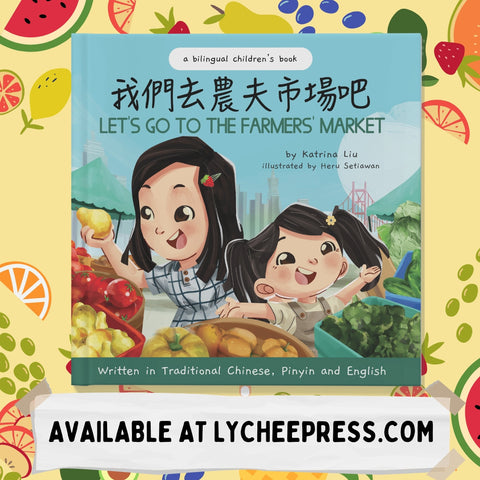Same but Different - Fruit Names in Chinese

As a writer and creator of bilingual books, one of the significant challenges I encountered while writing was deciding on the vocabulary, especially when describing various fruits. While coming up with my book "Let's Go to the Farmers' Market" I realized how the richness and diversity of the Chinese language bring forth numerous regional differences, especially between the North and the South of China and Taiwan. It was both a rewarding and enlightening experience to delve into the intricacies of these linguistic variations.
Let's dive into some of them!

🍅 Tomato (番茄 fān qié / 西紅柿 xī hóng shì)
The beloved tomato is a prime example of how names can differ in different Chinese-speaking regions. In some places, it is referred to as "番茄" (fān qié), while in others, it goes by the name "西紅柿" (xī hóng shì), both of which capture the essence of this red, luscious fruit.

🍊 Orange (橙子 chéng zi / 橘子 jú zi / 桔子 jú zi)
Oranges, with their vibrant color and juicy sweetness, are known by multiple names. "橙子" (chéng zi) is one way to refer to them, but you might also hear "橘子" (jú zi) or "桔子" (jú zi) used in other regions, each describing the delectable citrus fruit adored by many.

🍍 Pineapple (鳳梨 fèng lí / 菠蘿 bō luó)
The tropical delight, pineapple, is not immune to the variations in Chinese names. Some regions favor "鳳梨" (fèng lí) as the term for this sweet and spiky fruit, while others opt for "菠蘿" (bō luó), both encapsulating its unique characteristics.

🥝 Kiwi (獼猴桃 mí hóu táo / 奇異果 qí yì guǒ)
The kiwi fruit also has a couple of names in Chinese. You may hear it being called "獼猴桃" (mí hóu táo) in some regions, while in others, "奇異果" (qí yì guǒ) is the preferred term, highlighting the intriguing and exotic nature of this fuzzy fruit.

🥑 Avocado (牛油果 niú yóu guǒ / 鱷梨 è lí)
Avocado, known for its creamy texture and health benefits, also goes by different names. "牛油果" (niú yóu guǒ) is one way to refer to it, while some regions use the term "鱷梨" (è lí), which translates to "alligator pear," aptly describing its rough, pear-like appearance.

🍇 Grapes (葡萄 pú tao / 提子 tí zi)
Grapes, those delicious clusters of sweetness, have their fair share of name variations. "葡萄" (pú tao) is commonly used in some regions, while in others, "提子" (tí zi) is the preferred term, evoking the act of picking the grapes from the vine.
Fascinating, right? If you're intrigued and eager to discover more about the diverse ways of expressing things in Chinese, watch my upcoming discussions on veggies and dairy! A whole world of linguistic wonders is waiting to be explored, and I can't wait to share it with you! Get ready for the next exciting chapter in our language and culinary journey!
You can also share the gift of a second language by getting this book here, in my store. Check out the delicious sustainable organic produce, freshly baked goods, colorful flowers, and so much more with Let's Go to the Farmer's Market, available in English, Traditional Chinese, and Simplified Chinese. Grab yours now!

